| Listing 1 - 10 of 13 | << page >> |
Sort by
|
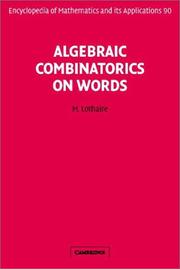
ISBN: 1139885685 1107103975 1107089557 110710145X 1107095875 110732601X 9781107089556 9781107326019 9781107095878 0521812208 9780521812207 9781139885683 9781107103979 9780521180719 0521180716 Year: 2002 Volume: v. 90 Publisher: Cambridge New York Cambridge University Press
Abstract | Keywords | Export | Availability | Bookmark
 Loading...
Loading...Choose an application
- Reference Manager
- EndNote
- RefWorks (Direct export to RefWorks)
Combinatorics on words has arisen independently within several branches of mathematics, for instance number theory, group theory and probability, and appears frequently in problems related to theoretical computer science. The first unified treatment of the area was given in Lothaire's book Combinatorics on Words. Originally published in 2002, this book presents several more topics and provides deeper insights into subjects discussed in the previous volume. An introductory chapter provides the reader with all the necessary background material. There are numerous examples, full proofs whenever possible and a notes section discussing further developments in the area. This book is both a comprehensive introduction to the subject and a valuable reference source for researchers.
Combinatorial analysis. --- Word problems (Mathematics) --- Problems, Word (Mathematics) --- Story problems (Mathematics) --- Mathematics --- Combinatorics --- Algebra --- Mathematical analysis
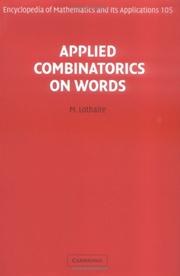
ISBN: 9781107341005 9780521848022 9781461938316 1461938317 1107341000 9781107387492 1107387493 9781107390416 1107390419 0521848024 1139883224 1107383986 110729956X 1107398827 1107395216 Year: 2005 Volume: v. 105 Publisher: Cambridge, UK New York Cambridge University Press
Abstract | Keywords | Export | Availability | Bookmark
 Loading...
Loading...Choose an application
- Reference Manager
- EndNote
- RefWorks (Direct export to RefWorks)
A series of important applications of combinatorics on words has emerged with the development of computerized text and string processing. The aim of this volume, the third in a trilogy, is to present a unified treatment of some of the major fields of applications. After an introduction that sets the scene and gathers together the basic facts, there follow chapters in which applications are considered in detail. The areas covered include core algorithms for text processing, natural language processing, speech processing, bioinformatics, and areas of applied mathematics such as combinatorial enumeration and fractal analysis. No special prerequisites are needed, and no familiarity with the application areas or with the material covered by the previous volumes is required. The breadth of application, combined with the inclusion of problems and algorithms and a complete bibliography will make this book ideal for graduate students and professionals in mathematics, computer science, biology and linguistics.
Combinatorial analysis. --- Word problems (Mathematics) --- Combinatorics --- Algebra --- Mathematical analysis --- Problems, Word (Mathematics) --- Story problems (Mathematics) --- Mathematics --- Combinatorial analysis
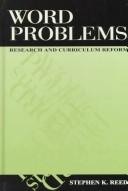
ISBN: 0805826610 9780805826616 9781410604484 9781135684297 9781135684334 9781135684341 9780805826609 Year: 1999 Publisher: Mahwah (N.J.): Erlbaum, Lawrence, Associates,
Abstract | Keywords | Export | Availability | Bookmark
 Loading...
Loading...Choose an application
- Reference Manager
- EndNote
- RefWorks (Direct export to RefWorks)
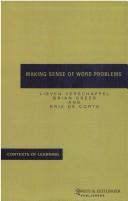
ISBN: 9026516282 9789026516283 Year: 2000 Publisher: Lisse [Netherlands]: Swets & Zeitlinger,
Abstract | Keywords | Export | Availability | Bookmark
 Loading...
Loading...Choose an application
- Reference Manager
- EndNote
- RefWorks (Direct export to RefWorks)
Didactics of mathematics --- Word problems (Mathematics) --- Problem solving --- Study and teaching. --- -Word problems (Mathematics) --- -Academic collection --- #PBIB:2001.1 --- Problems, Word (Mathematics) --- Story problems (Mathematics) --- Mathematics --- Methodology --- Psychology --- Decision making --- Executive functions (Neuropsychology) --- Study and teaching --- Academic collection --- Word problems (Mathematics) - Study and teaching. --- Problem solving - Study and teaching.

ISBN: 0201135167 9780201135169 Year: 1983 Volume: 17 Publisher: Reading (Mass.): Addison-Wesley,
Abstract | Keywords | Export | Availability | Bookmark
 Loading...
Loading...Choose an application
- Reference Manager
- EndNote
- RefWorks (Direct export to RefWorks)
Mathematical linguistics --- Discrete mathematics --- Grammar --- Word problems (Mathematics) --- Combinatorial analysis --- 519.1 --- 512 --- 681.3*F4 --- Problems, Word (Mathematics) --- Story problems (Mathematics) --- Mathematics --- Combinatorics --- Algebra --- Mathematical analysis --- Combinatorics. Graph theory --- Mathematical logic and formal languages (Theory of computation) --- Combinatorial analysis. --- Word problems (Mathematics). --- 681.3*F4 Mathematical logic and formal languages (Theory of computation) --- 512 Algebra --- 519.1 Combinatorics. Graph theory
Book
ISBN: 9401205612 1435633105 9781435633100 9789401205610 9042023708 9789042023703 9042023708 9789042023703 Year: 2008 Publisher: Amsterdam New York Rodopi
Abstract | Keywords | Export | Availability | Bookmark
 Loading...
Loading...Choose an application
- Reference Manager
- EndNote
- RefWorks (Direct export to RefWorks)
You are invited to join a fascinating journey of discovery, as Marcia Birken and Anne C. Coon explore the intersecting patterns of mathematics and poetry — bringing the two fields together in a new way. Setting the tone with humor and illustrating each chapter with countless examples, Birken and Coon begin with patterns we can see, hear, and feel and then move to more complex patterns. Number systems and nursery rhymes lead to the Golden Mean and sestinas. Simple patterns of shape introduce tessellations and concrete poetry. Fractal geometry makes fractal poetry possible. Ultimately, patterns for the mind lead to questions: How do mathematicians and poets conceive of proof, paradox, and infinity? What role does analogy play in mathematical discovery and poetic expression? The book will be of special interest to readers who enjoy looking for connections across traditional disciplinary boundaries. Discovering Patterns in Mathematics and Poetry features centuries of creative work by mathematicians, poets, and artists, including Fibonacci, Albrecht Dürer, M. C. Escher, David Hilbert, Benoit Mandelbrot, William Shakespeare, Edna St. Vincent Millay, Langston Hughes, E.E. Cummings, and many contemporary experimental poets. Original illustrations include digital photographs, mathematical and poetic models, and fractal imagery.
Mathematics and literature. --- Logic, Symbolic and mathematical. --- Word problems (Mathematics) --- Poetics. --- Pattern perception. --- Problems, Word (Mathematics) --- Story problems (Mathematics) --- Mathematics --- Poetry --- Design perception --- Pattern recognition --- Form perception --- Perception --- Figure-ground perception --- Literature and mathematics --- Literature --- Algebra of logic --- Logic, Universal --- Mathematical logic --- Symbolic and mathematical logic --- Symbolic logic --- Algebra, Abstract --- Metamathematics --- Set theory --- Syllogism --- Technique
Book
ISBN: 1493907484 1493907476 Year: 2014 Publisher: New York, NY : Springer New York : Imprint: Springer,
Abstract | Keywords | Export | Availability | Bookmark
 Loading...
Loading...Choose an application
- Reference Manager
- EndNote
- RefWorks (Direct export to RefWorks)
The Compressed Word Problem for Groups provides a detailed exposition of known results on the compressed word problem, emphasizing efficient algorithms for the compressed word problem in various groups. The author presents the necessary background along with the most recent results on the compressed word problem to create a cohesive self-contained book accessible to computer scientists as well as mathematicians. Readers will quickly reach the frontier of current research which makes the book especially appealing for students looking for a currently active research topic at the intersection of group theory and computer science. The word problem introduced in 1910 by Max Dehn is one of the most important decision problems in group theory. For many groups, highly efficient algorithms for the word problem exist. In recent years, a new technique based on data compression for providing more efficient algorithms for word problems, has been developed, by representing long words over group generators in a compressed form using a straight-line program. Algorithmic techniques used for manipulating compressed words has shown that the compressed word problem can be solved in polynomial time for a large class of groups such as free groups, graph groups and nilpotent groups. These results have important implications for algorithmic questions related to automorphism groups.
Word problems (Mathematics) --- Group theory. --- Mathematics. --- Math --- Science --- Groups, Theory of --- Substitutions (Mathematics) --- Algebra --- Problems, Word (Mathematics) --- Story problems (Mathematics) --- Mathematics --- Topological Groups. --- Global analysis (Mathematics). --- Group Theory and Generalizations. --- Topological Groups, Lie Groups. --- Analysis. --- Analysis, Global (Mathematics) --- Differential topology --- Functions of complex variables --- Geometry, Algebraic --- Groups, Topological --- Continuous groups --- Topological groups. --- Lie groups. --- Mathematical analysis. --- Analysis (Mathematics). --- 517.1 Mathematical analysis --- Mathematical analysis --- Groups, Lie --- Lie algebras --- Symmetric spaces --- Topological groups

ISBN: 0511527896 0521430720 0521043697 Year: 1995 Publisher: Cambridge : Cambridge University Press,
Abstract | Keywords | Export | Availability | Bookmark
 Loading...
Loading...Choose an application
- Reference Manager
- EndNote
- RefWorks (Direct export to RefWorks)
Schemas in Problem Solving explores a theory of schema development and studies the applicability of the theory as a unified basis for understanding learning, instruction and assessment. The theory's prescriptions for teaching are direct, and its application to assessment suggests new directions for tests. After examining the roots of the theory in earlier work by philosophers and psychologists, Marshall illustrates the main features of her theory with experimental evidence from students who are learning to recognize and solve arithmetic story problems. She describes individual performance with traditional empirical studies as well as computer simulation. The computer simulation reflects an approach in modelling cognition. Marshall's model links neural networks with symbolic systems to form a hybrid model that uses pattern matching of sets of features as well as logical step-by-step rules.
Schemas (Psychology) --- Problem solving. --- Learning, Psychology of. --- Word problems (Mathematics) --- Educational tests and measurements. --- Educational assessment --- Educational measurements --- Mental tests --- Tests and measurements in education --- Psychological tests for children --- Psychometrics --- Students --- Examinations --- Psychological tests --- Problems, Word (Mathematics) --- Story problems (Mathematics) --- Mathematics --- Learning --- Psychology of learning --- Educational psychology --- Comprehension --- Learning ability --- Methodology --- Psychology --- Decision making --- Executive functions (Neuropsychology) --- Mental models --- Models, Mental --- Psychological schemas --- Schemata (Cognition) --- Schemata (Psychology) --- Scripts (Psychology) --- Cognition --- Rating of --- Psychological aspects --- Health Sciences --- Psychiatry & Psychology
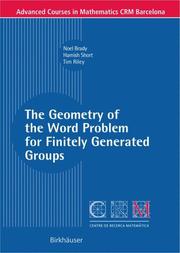
ISBN: 3764379502 9783764379490 3764379499 9783764379506 Year: 2007 Publisher: Basel : Birkhäuser Basel : Imprint: Birkhäuser,
Abstract | Keywords | Export | Availability | Bookmark
 Loading...
Loading...Choose an application
- Reference Manager
- EndNote
- RefWorks (Direct export to RefWorks)
The advanced course on The geometry of the word problem for ?nitely presented groups was held July 5-15, 2005, at the Centre de Recerca Matematica ` in B- laterra (Barcelona). It was aimed at young researchersand recent graduates int- ested in geometricapproachesto grouptheory,in particular,to the wordproblem. Three eight-hour lecture series were delivered and are the origin of these notes. There were also problem sessions and eight contributed talks. The course was the closing activity of a research program on The geometry of the word problem, held during the academic year 2004-05 and coordinated by Jos´ eBurilloandEnricVenturafromtheUniversitatPolit` ecnicadeCatalunya,and Noel Brady,fromOklahoma University. Thirty-?vescientists participated in these events, in visits to the CRM of between one week and the whole year. Two weekly seminars and countless informal meetings contributed to a dynamic atmosphere of research. The authors of these notes would like to express their gratitude to the m- velous sta? at the CRM, director Manuel Castellet and all the secretaries, for providing great facilities and a very pleasant working environment. Also, the - thors thank Jos´ e Burillo and Enric Ventura for organising the research year, for ensuring its smooth running, and for the invitations to give lecture series. - nally, thanks are due to all those who attended the courses for their interest, their questions, and their enthusiasm.
Geometric group theory. --- Finite groups. --- Word problems (Mathematics) --- Problems, Word (Mathematics) --- Story problems (Mathematics) --- Mathematics --- Groups, Finite --- Group theory --- Modules (Algebra) --- Word problems (Mathematics). --- Group theory. --- Discrete groups. --- Combinatorics. --- Algebra. --- Group Theory and Generalizations. --- Convex and Discrete Geometry. --- Order, Lattices, Ordered Algebraic Structures. --- Mathematical analysis --- Combinatorics --- Algebra --- Groups, Discrete --- Infinite groups --- Groups, Theory of --- Substitutions (Mathematics) --- Discrete mathematics --- Finite groups --- Geometric group theory --- 512.54 --- 514.7 --- 512.54 Groups. Group theory --- Groups. Group theory --- 514.7 Differential geometry. Algebraic and analytic methods in geometry --- Differential geometry. Algebraic and analytic methods in geometry --- Convex geometry . --- Discrete geometry. --- Ordered algebraic structures. --- Algebraic structures, Ordered --- Structures, Ordered algebraic --- Geometry --- Combinatorial geometry --- Convex geometry. --- Combinatorial analysis.
Book
ISBN: 072042271X 9780720422719 Year: 1973 Volume: 71 Publisher: Amsterdam: North-Holland,
Abstract | Keywords | Export | Availability | Bookmark
 Loading...
Loading...Choose an application
- Reference Manager
- EndNote
- RefWorks (Direct export to RefWorks)
Group theory --- Groupes, Théorie des --- Burnside, Problème de --- Burnside problem --- Groupes, Théorie des. --- Burnside, Problème de. --- Gödel's theorem --- Word problems (Mathematics) --- Théorème de Gödel --- Problèmes des mots (Mathématiques) --- Burnside, Problème de --- Congresses --- Congrès --- ELSEVIER-B EPUB-LIV-FT --- Burnside problem. --- Gödel's theorem --- Word problems (Mathematics). --- Congresses. --- 510.6 --- Groupes, Théorie des --- Décidabilité (logique mathématique) --- 510.6 Mathematical logic --- Mathematical logic --- Problems, Word (Mathematics) --- Story problems (Mathematics) --- Mathematics --- Gödel's incompleteness theorem --- Undecidable theories --- Arithmetic --- Completeness theorem --- Incompleteness theorems --- Logic, Symbolic and mathematical --- Number theory --- Decidability (Mathematical logic) --- Problem, Burnside --- Finite groups --- Foundations --- Generators --- Relations --- Group theory - Congresses --- Groupes (algebre) --- Structures algebriques --- Generateurs --- Probleme du mot --- Burnside, Problème de.
| Listing 1 - 10 of 13 | << page >> |
Sort by
|

 Search
Search Feedback
Feedback About UniCat
About UniCat  Help
Help News
News